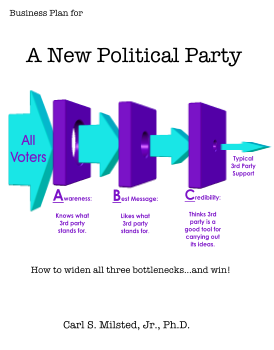Holding Things Together
OK, I think I have covered membership acquisition and credibility-while-small sufficiently. Should these measures be sufficient, we then arrive at the problem of keeping the membership together.
A true political party is a coalition or it is a joke. This means that agreement upon strict principles is going to be difficult, definitive platforms will be hard to craft. We will have people of very different backgrounds under the same roof, metaphorically.
Here are a few ideas directed at this problem.
-
Better parliamentary procedures. I already covered this one (under Dedication) but it bears repeating.
-
A social club model. Let there be multiple clubs in an area. The Democrats and Republicans in my area have multiple organizations within the same county. Let activists with different taste participate differently.
-
A fuzzy platform. The national message could be more descriptive than prescriptive. Conventions could try to agree on broad statements. Multiple specific solutions could conform to these principles. Different candidates could advocate different particular solutions. For example, the platform could call for simpler taxes, which preserve privacy, reduce bureaucracy, and approximate user fees. Some might interpret this as calling for the Fair Tax. Others might interpret this as a call for the Georgist Single Tax.
-
An organic program. While the platform is vague, outreach materials need to provide specific solutions. But these solution materials could be descriptive instead of prescriptive. They could describe multiple conforming solutions. The convention could elect a committee whose purpose is to generate/approve such outreach materials. This committee would be separate from the operations committee.
-
Lotteries. Where there is a need for focus, and multiple options are equally desirable, it might be best to choose by lot. This can produce less acrimony than even the best democratic procedures.
-
Set the message before recruiting. Write a manifesto, platform and program before bringing many people in. Recruit those who like the message as it originally stands. Then, future conventions will only have the task of tweaking the message, vs. flushing out a bare outline.
-
Internal education. New members should be encouraged to understand why the party takes its positions.
-
Selectively recruit members who will be active. Donít beg people to join. Those who are lukewarm on the message can be noted as potential votes without being asked to show up for meetings etc. (Some may ask to join. Let them. Just donít beg them.)
Note: I do not expect the last three measures to result in enshrining the initial platform for all time. I just hope to provide enough stability so that the initial recruits are happy with where the party winds up as it grows.
I definitely do not think the new party should adopt a statement of principles that requires undue effort to modify. Nor do I approve of a membership oath.
Note that the Libertarian Party has a great deal of acrimony because it has historically violated number 8 while at the same time trying to remain pure. Many a person has signed the LP membership oath without fully realizing its import. Many were shown the Nolan Chart, told they were libertarians, and then asked to join. Upon getting active, these people were then informed that they werenít actually true libertarians. This is the Bait and Switch tactic which is the underlying source of the LPís culture of acrimony.
Previous
| 1
| 2
| 3
| 4
| 5
| 6
| 7
| 8 | 9
| 10
| 11
| Next
Copyright 2007, Carl S. Milsted, Jr. All rights reserved.
|
|






